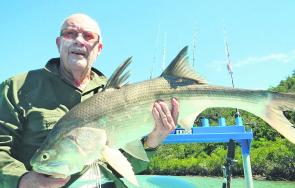Rank weather patterns have put a damper on many angler’s trips during the past month. Wet and windy days have been the predominant pattern, which is a bit different to previous years.
Apart from being uncomfortable, the worst part about this sort of weather is it puts the fish off and they vanish to deeper waters and go off the chew. For many local anglers it’s a good time to stay home and catch up with other things, but if you have come from a thousand kilometres away it can be a frustrating time.
This pattern usually happens when the waters are cooling and doesn’t seem to be as bad when the waters are warmer like in February or March. So my best advice when there is cold water, wind and rain is simply stay home.
I have not heard many reports of late, but my charters have still seen quite a few happy anglers with the odd big day on the threadfin and some reasonable barra. But we have also seen a few slow trips and doesn’t matter how hard you try on those days, there is not much you can do to find fish and make them chew. We are hoping that June will bring some great weather with it and of course some great fishing.
I would also like to remind visiting anglers about the green zones, particularly around the Brooke Islands, as there have been a few groups getting booked for doing the wrong thing. Ignorance will get you nowhere when the rangers are writing you up. It is a well known fact among fishers nowadays, and doesn’t matter where you go, you should always check the local zoning maps. These zones are put in place for a reason and should be avoided at all costs. It will save you some embarrassment and big hit to your wallet.
In June, anglers should turn their attention to the pelagics as our inshore areas should hot up for Spaniards, tuna, and GT. Spaniards will be found around most pressure points where the current bounces up off a rock, headland or underwater ridge. Floating pillies in the current should produce well and change over to metal slices when the current is finished.
GT will be found in similar areas, as well as shallow bommie country that breaks the surface at low tide. Around wrecks is another place to look for these brutes. Big poppers and metal slices will account for most specimens.
Northern Bluefin tuna will pop up anywhere that there is bait. They like to feed on juvenile herrings as small as 1” long, and small slices are the way to go. Follow the schools and get your slice in amongst them when they break the surface feeding. This is the only way to get them to bite.
The reef should fire on the making tides in June and the shallow drop-offs are a good place to start looking for many species such as coral trout and red throat emperor.
In the estuaries, the golden snapper should fire up as they do in winter and golden grunter will also make their presence felt.
Depending on how cold it gets will govern barra movements. Water below 23ºC will see them back off substantially, except the small school-sized fish in the drains, particularly if there is a low tide in the middle of the day or afternoon.
If you would like to pop up for a winter charter we will be targeting reds and Spaniards on the wonky holes around the Palm Islands. There are still a few good dates available for barra in September and October if you get in quickly.
Contact us at www.hookedonhinchinbrook.com
Reads: 1215
John Blaik with a decent king threadfin salmon.




